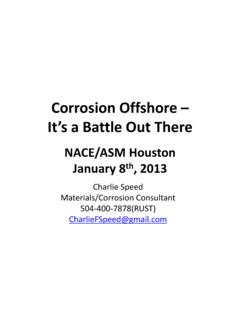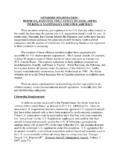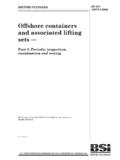Transcription of The Use of Coatings for Corrosion Control on …
1 The Use of Coatings for Corrosion Control on offshore Oil Structures J. Peter Ault, Consultant Ocean City, NJ Protective Coatings are ubiquitous on offshore oil structures. As with most situations, the use of Coatings is driven by myriad factors unique to the industry. The paper will provide an overview of the types of structures, the Coatings used in different zones of the structures, and the pragmatic and regulatory criteria which influence the coating process. The offshore Oil and Gas Industry Approximately 30% of the US domestic oil production and 20% of the domestic gas production is generated from the outer continental shelf (OCS).
2 By far the majority of that production is in the Gulf of Mexico. The remainder of US domestic production is in the Pacific and Alaska regions (which have similar production levels) and the Atlantic region (which is a distant fourth in terms of production). Beyond the current production, OCS resources are projected to contain the majority of undiscovered gas and oil in the United States. The OCS Lands Act (Title 43, Chapter 29 of the US Administrative Code) required the Department of the Interior to manage Federal offshore lands used for oil and gas production. The DOI determines the size, timing and location of areas to be used and ensures that the US Governments is fairly compensated for acreage made available through leases.
3 Importantly, the DOI is also charged with responsibility to protect the environment and ensure that the offshore activities operate safely. The DOI carries out these operations through the Mineral Management Service (MMS). The MMS offshore program coordinates the extensive offshore production activities. The key mechanism includes frequent Notices to Lessees and Operators (NTL) as well as the Federal Administrative Record (FAR) Extensive infrastructure is required to support the offshore production industry. There are more that 6500 offshore oil and gas installations in some 53 countries around the world.
4 More than 50% of these installations are in the US Gulf of Mexico. The next five largest areas in descending order are Asia, Middle East, North Sea, West Africa coast, and South America. These six regions account for the majority of the existing offshore oil and gas installations. The installations are built for exploration (drilling) and production (including preparing water or gas for injection, processing oil or gas, cleaning produced water for disposal, and various accommodations). There are several types of drilling rigs including: Jackups usually towed to a location after which the legs are lowered to the seabed and the hull is jacked above the sea surface.
5 Drill Ships look like ordinary ships with a derrick on top which drills through a hole in the hull. They can be anchored or positioned with computer-controlled propulsion systems. Submersibles can be floated to shallow water locations and ballasted to sit on the seabed. Semi-submersibles have the superstructure supported on a hull or pontoons which are ballasted below the water surface. Once the drilling rigs have completed their work, they are generally replaced by production platforms. Production platforms vary in size and shape, but generally contain accommodations for larger crews and the various production processes required to extract the oil or gas and render it suitable for transport.
6 Sometimes smaller, satellite platforms will be situated around a larger production platform. Production platform types include: Fixed production platforms typically constructed of steel and attached to the seabed with piles. Floating Production Storage Offloading (FPSO) and Floating Storage and Offloading (FSO) vessel either anchored or tethered. Tension Leg Platform (TLP) typically used in deepwater applications, these platforms are built from steel or concrete and anchored to the sea floor with vertical tendons. Other supporting infrastructure for the offshore oil and gas industry includes the ships and aircraft which transport people and supplies to the platforms and pipelines which transfer the product back to refineries and other users on shore.
7 For the purposes of this paper we will focus on Coatings used for the offshore structures themselves. Considerations for Corrosion Control Perhaps the most obvious consideration for Corrosion Control of offshore structures is the marine environment in which they operate. An offshore platform has significant exposure in seawater immersion, splash zone, and salt air. Corrosion of steel in these environments can be greater than 100 mils per year. Corrosion rates are highest in the splash zone as illustrated in figure 1. In addition to the marine environment, offshore platforms have areas subjected to severe abrasion and highly corrosive water chemistries.
8 For floating structures, ballast tank interiors comprise a significance portion of the coated surface. Figure 1 - Steel Corrosion Rate Relative to Sea Level024681012141618 Typical Steel Corrosion Rate, mils per yearElevationMarine AtmosphereSplash ZoneQuiescent SeawaterMud LineHigh Tide LevelLow Tide LevelTidal ZoneOcean Bottom Since offshore platforms appear similar in many respects to ships, it might be anticipated that much of the Corrosion Control design would be similar. Indeed, most coating systems are heavy duty epoxies which are also common on ships. Inorganic zinc pre-construction primers are used in new construction, and may be repaid and kept depending on the design philosophy of the owner.
9 Cathodic protection is typically used below the waterline. However there are some substantial differences between the operating environments for ships versus offshore platforms. For example, once located at sea, offshore platforms rarely come back to port for maintenance whereas a ship is frequently drydocked. offshore platforms do not usually have the same weight consideration as ships, allowing the use of sacrificial cathodic protection as the sole method of Corrosion Control for the underwater portions in some instances. Even among offshore platforms, different design considerations exist. Weight reduction is a more important issue for FPSO s than fixed structures.
10 Corrosion Control on offshore structures commonly includes the following five approaches (though this paper will focus on the use of Coatings ): No Protection (wastage allowance) Protective Coatings Cathodic Protection of Bare Steel Cathodic Protection of Coated Steel Corrosion Resistant Metallic or Plastic Corrosion Control Coatings In the early days of offshore oil and gas production (1940 s 1950 s) protective coating systems typically consisted of vinyl or chlorinated rubber Coatings . The typical system for the atmospheric exposed areas was multiple coats with a total build of 250-300 microns (10-12 mils).







